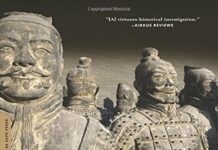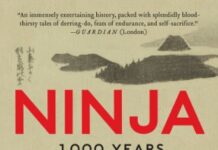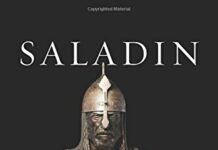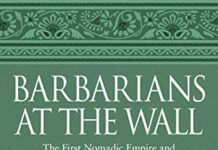
Ebook Info
- Published: 2016
- Number of pages: 400 pages
- Format: PDF
- File Size: 4.62 MB
- Authors: John Man
Description
Genghis Khan is one of history’s immortals: believing he was divinely protected, he united warring clans to create an empire that ran across much of Asia. Under his grandson, Kublai Khan, the vision evolved into a more complex religious ideology, justifying further expansion. Kublai doubled the empire’s size until, in the late 13th century, he and the rest of Genghis’s ‘Golden Family’ controlled one fifth of the inhabited world. Along the way, he conquered all China, gave the nation the borders it has today, and then, finally, discovered the limits to growth. In terms of the sheer scale of the conquests, never has a vision and the character of one man had such an effect on the world. This book provides a unique account of the Mongol Empire, from young Genghis to old Kublai, from a rejected teenager to the world’s most powerful emperor.
User’s Reviews
Editorial Reviews: Review “Wonderful . . . what sets it apart is the way the tale is told. Quirky digressions and fascinating anecdotes pepper a narrative of wonderful dramatic energy.” —Gerard DeGroot, The Times”Excellent and profoundly committed . . . Man provides a vivid, lucid and economical picture. A worthy addition to the burgeoning popular literature on the centaurs of the steppes.” —Frank McLynn, Literary Review”[Man] does a splendid job of conveying the sheer opulence and grandeur . . . [and tells] a rollicking good story, his historical narrative interspersed with high-spirited travel-writerly digressions. Lively and engaging.” —Justin Marozzi, Spectator”A very lively and enjoyable book.” —Peter Lewis, Daily Mail About the Author John Man is a historian whose books, published in over 20 languages, include the bestselling Genghis Khan: Life, Death and Resurrection,Ninja: 1,000 Years of the Shadow Warrior, and Samurai: The Last Warrior.
Reviews from Amazon users which were colected at the time this book was published on the website:
⭐Mostly consists of things that can be looked up on any historical site. It covers very little about individual incidents or character and personal behavior of Ghengis,, or Kublai for that matter.
⭐Great book! Very interesting and informative!
⭐Great detail and great read.
⭐Not an absorbing book. Language could have been better.
⭐The explosive spread of Islamic rule within less than a century of Muhammad’s death in 632 is well known: by 750 it extended from the Pyrenees to North-West India.But this was as nothing compared with the expansion of the Mongol Empire from the birth of Ghengiz Khan in 1162 to the death of Kublai Khan in 1294: it included what is today most of Ukraine, the Russian steppes, the Caucasus, Eastern Turkey, Eastern Syria, Eastern Iraq, Iran, Kazakhstan, Uzbekistan, Kyrgyizstan, Tajikistan, Afghanistan, Western Pakistan, Mongolia, North Korea – and the whole China, and with the Baltic states and Northern Russia being tributaries. Mongol raiders had also ravaged Georgia, Southern Ukraine and the Volga Basin between 1221 and 1223, and Poland, Hungary, parts of Austria and Bulgaria between 1236 and 1242.The conquests of Islam had involved little, if any, deliberate killing off the battlefields. By contrast, the slaughter by the Mongols, the extent of their plunder and the destruction they wrought on any cities that had resisted them were horrendous and quite unparalleled in history. The only positive feature of their rule was religious toleration.While the general impression is fairly easy to grasp, the book is difficult to read because of its sheer complexity. And it is impossible to follow the text – especially, but not exclusively, about campaigns – because there is a quite scandalous absence on the just four maps of many places named in it. (Maps on the internet or in the Times Atlas of World History are not of much help either.) This absence is the reason for my giving the book a three-star instead of a four-star rating.The story begins with the life of Genghiz. By 1189 he was undisputed master over the whole of his native Mongolia and had been acclaimed as Khan. By 1216 he had conquered the Jin Empire in northern China, its capital Bejing ransacked and the scene of an enormous massacre. Then he drove westward along the Silk Road (Samarkand, Bokhara, Merv etc.) and down into Afghanistan: those cities that surrendered to him without a fight were spared; the populations of those who resisted were massacred. From that base, the Mongols made plundering raids into Georgia, Southern Ukraine before returning to base via the Volga basin.Genghiz Khan died in 1227. He had four sons:Batu, the son of the ELDEST of these would be the founder of the Kipchak Khanate, better known as the Golden Horde, in Russia. It reached its apogee when in 1251 Alexander Nevsky, Prince of Novgorod, a principality with a Baltic coast, submitted to the Golden Horde. Man devotes just three pages to the history of the Golden Horde: the Kipchak Khanate would break up into separate khanates in the 15th century which over the next two centuries would fall to Poland, Russia and the Ottoman Empire.The SECOND son would found the Chaghadai Khanate in Central Asia, based on Samarkand. Man’s account of this Khanate and its final collapse in 1347 is the sketchiest of the lot (just over one page; and the last 76 years of the Il Khanate – see below – takes just three pages). Man’s interest is overwhelmingly in the history of the Great Khanate.Ghengiz Khan had nominated his THIRD son, Ogedei, to succeed him as the Great Khan. His lands were Mongolia and Northern China. Ogedei was a heavy drinker and personally rather ineffective, but he had able subordinates: Yelu Chucai who was made governor of the parts of Northern China that had been conquered, and who introduced rather good government in that area; and Subedei, a brilliant general who, with Ogedei’s nephew Batu, expanded the empire to the West and made the spectacular raids of 1236 to 1242, referred to above, before withdrawing to Batu’s base on the Volga.When Ogedei died in 1241, there was some dispute among the family about who should succeed him as Great Khan. It took three years to resolve (without bloodshed), and in 1245 Ogedei’s son Guyuk was acknowledged as the Great Khan. After he died in 1248, there was another three-year-long dispute about the succession before that was resolved, in a bloodier manner than last time.The next two Great Khans were Möhnke (1251 to 1259) and his brother Kublai Khan (1260 to 1294). They were the descendants of Ghengiz’s FOURTH son. Möhnke expanded his empire into the Muslim world, taking advantage of the weakening Abbasid Empire to create the Il-Khanate of Persia under his third brother, Hulegu. Baghdad, the Abbasid capital, fell to Hulegu’s armies in 1258 with the slaughter of its 800,000 inhabitants, including all the members of the Abbasid dynasty. Next the Mongols overran Syria and moved into Egypt; but there the advance was checked: on the news of Möhnke’s death in 1259, the Mongols withdrew some of their forces, and the remainder were defeated and exterminated by the Mamelukes of Egypt in 1260. The Il Khanate would simply expire with the death of the last Il Khan in 1335.Möhnke had died while he and Kublai were each leading an army invading the Song Empire in southern China. Kublai succeeded Möhnke as Great Khan in 1260. It took him five years to put down a challenge for the Great Khanate by the youngest of his brothers and to subdue a rebellion of a war-lord in Northern China.Kublai had already created a new quasi-capital at Xanadu. (The official capital of the Mongol Empire was Karakoram, which had replaced Genghiz Khan’s capital of Avraga under Ogedei.) In 1264 Kublai created an additional capital just outside the former North Chinese (Jin) capital at Beijing, on the site which was to become the Forbidden City; and he commuted between Xanadu and Beijing. The Mongols had already relied heavily on Chinese for their civil service, and by building the great palace at Beijing, Kublai Khan wanted to signal that the dynasty was now as much Chinese at it was Mongolian, and it was now called the Yuan dynasty. Today the Chinese recognize it as a Chinese dynasty, and as Ghengiz Khan was its progenitor, they honour him retrospectively as one of the founders of China, and one guide even told Man that Genghiz was Chinese!In 1268 Kublai sent his generals to finally conquer Song China. It took eight years before the Chinese government surrendered, and two more before the last resistance was bloodily crushed. Kublai was now the ruler of the whole of China (and of Tibet which had submitted without a fight, in 1269). We have seen that in the course of the 14th century the other three khanates would collapse, and so, for that matter, would the Yuan dynasty; but the legacy of Kublai Khan in creating the idea of a united China was much more enduring than that of the other three khanates.After the ferocity of the conquest of China, the rule of the Mongols, though firm and centralized, was largely sufficiently benign and efficient to be acceptable to its people. The Mongols were on top, but all other ethnicities were involved in administration and all religions were tolerated. The economy and culture flourished. (But a later chapter shows that Kublai’s top financial minister in China for fourteen years was extortionate, corrupt and hugely unpopular. He was murdered in 1282.)But towards the end of Kublai’s reign his attempts to expand his empire still further were failures:To conquer southern China, with its mighty rivers, the Mongols had constructed a fleet, and this was now used in attempts to spread Mongol power to Japan. After an earlier failed attempt in 1274, in 1281 a huge fleet of some 1,500 warships and 3,500 landing craft, carrying 150,000 men between them, tried again. Their landings met with fierce resistance and the invaders were defeated in several battles. Then a typhoon approached: most of those who had landed hurried back on board and the fleet tried to head out to sea to avoid being dashed on the rocks; but when the typhoon struck, most of the fleet was smashed and 65,000 men perished at sea and thousands more were killed on the beaches.Attempts to subjugate Burma in 1286, Vietnam in 1288 and Java (again by sea) in 1292 also failed. Kublai Khan died in 1294, in his eightieth year.Man gives a sketchy account of the disintegration of the Mongol Empire in China after the death of Kublai Khan. Ten Yuan Great Khans ruled during the next 74 years, each weaker than his predecessor, until in 1368 the last of the dynasty was overthrown by a Chinese warrior who founded the Ming dynasty. The Yuans held on in Mongolia until 1635 when Mongolia would be absorbed by the then Manchu rulers of China.Man’s last three chapters reflect, in part, on the history of the preceding twenty-three. Most notable is his comment that the Mongols, unlike other great empires like those of Rome, of Alexander the Great and of Islam, they made no contribution to the history of ideas: they had no ideology, no philosophies, no ethical systems, no literature or art of their own. They stood for nothing except for the idea that they had the Mandate of Heaven to conquer the whole world.
⭐For the first two thirds of this book, the author provides a perfectly readable history of the origins of Genghis Khan and his immediate two ancestors. The source material is difficult and the author does a good job of picking through what is available to provide as good an account as any of Genghis and the Mongol Empire’s foundation.Unfortunately this promising start dissolves into a strange brand of Gonzo history where the author puts themselves at the centre of the action to the point where it starts to feel more like a travel guide written by a third rate Indiana Jones than a serious history. What makes this worse is that the alleged discoveries the author makes are mind blowingly mundane: I went to a place, nothing happened, but something might have happened at some point, we don’t know. Great. We could have quite happily skipped all of this. Unfortunately for the author that would have meant writing about Mongol history post Kublai Khan which seems to have been omitted because it was too complicated.This omission seriously undermines the claims of the title to be a book about Genghis’ heirs. There is no mention here of the succeeding khanates some of which lasted until 1920, very little on the Mughals, and nothing at all on Tamerlaine. The result is the book drifts to the end on the back of vaguely interesting travel anecdotes when there so much more Mongol history to tell.If you want a history of the first three Mongol Emperors then the first two thirds of this book will meet your requirements, if you want a wider history look elsewhere.
⭐Author John Man takes us from the youth of Temujin, and how he became Genghis Khan and built an empire that crossed Asia into Europe, to his descendants – not just Ogedai and Kublai, but all the branches of his family, taking us into the internecine feuds and jostling for power while the empire Genghis has founded doubled in size, and then caused it to fracture and split.He does a wonderful job of following the often tortuous paths of history with clarity, but also setting them in the context and feel of time and place; the attitudes of the lands and nations who faced the Mongols, well-argued reasons for why they fell or resisted. The canvas is vast, and he introduced me to many aspects of this history of which I was entirely unaware: the facts that the Turks were a earlier wave of settlers from the same part of the world, the Mongol conquest of the entirety of Asian Islam, the fact that European Christian crusaders allied with the Mongols on more than one occasion ( from a belief that they represented the mythical Eastern Christian emperor Prester John to simple practicality of fighting the same opponent ), the failed invasions of Vietnam and Japan, the off-hand remark that modern Pakistan was part of the empire. Each of these and more could fill volumes in their own right, and I hope I can find accounts written as well as this.Not that this book is simply a brief overview, Man goes into detail that is substantial and in depth, but not overwhelming. Early on I had been perhaps a little disparaging of his narrative style, but that was entirely unfair; while quite different from the style of, say, Tom Holland, one of my personal favourites and a consummate writer of narrative histories. While initially it seems that Man is rushing through events and piling up detail, he circles back and suddenly he is building a narrative picture that has drawn the reader right into the heart of the story. His main achievement, though, is the way he connects the events to modern history, not only the China ( including how the Chinese claim Genghis for their own ) but Russia, the ‘Stans, the Middle East and even how it moulded medieval Japan.I do have to say that one problem with the book is the way he deals – or doesn’t deal – with rape. This becomes especially apparent in a later section when he revisits the fact that one of Genghis’ sons was viewed ( possibly correctly ) as illegitimate as his mother had been held captive by an enemy tribe for several months, as well as the fact of Y-chromosomes originating in Mongolia being widespread throughout Asia and Europe. He states these matters as simply that, without acknowledging the sexual violence implicit in both. I’m sure the author would say something along the lines of “it was a simple fact of how the world was then”, but he doesn’t say anything in the text and this omission, whether he feels it irrelevant, or is uncomfortable with the subject, leaves for me a troublesome gap that should at least have been recognised.
⭐If you are interested in the history of Genghis Kahn alone, only about 120 pages of this book cover that, the remaining is about his descendants, modern day events, places in Mongolia and the rest of the world. While the book’s title is indeed ‘The Mongol Empire’ I expected more focus on Genghis himself. The author also constantly reverts to current day events and his own experiences which is good but it feels out of place sometimes and almost self-centred. It is a good read, the parts concerning Genghis Khan and Kublai Khan are very captivating, Genghis’s part in particular is told with great lyrical beauty and the events are described masterfully, to the point where sometimes the remaining of the book feels like filler. I recommend the book for Genghis’s part alone and if you want to know more about the legacy of the man.
⭐I went into this book knowing little but got so much of profound interest from it. The Mongols were as astonishing as their legend and they left a subtle but extraordinarily wide-ranging legacy that can still be felt. Find out in the company of a master.
⭐Very interesting read all written in a easy to follow manner. The last section was, to me not real of much interest, but other wise I went from cover to cover.
Keywords
Free Download The Mongol Empire: Genghis Khan, His Heirs and the Founding of Modern China in PDF format
The Mongol Empire: Genghis Khan, His Heirs and the Founding of Modern China PDF Free Download
Download The Mongol Empire: Genghis Khan, His Heirs and the Founding of Modern China 2016 PDF Free
The Mongol Empire: Genghis Khan, His Heirs and the Founding of Modern China 2016 PDF Free Download
Download The Mongol Empire: Genghis Khan, His Heirs and the Founding of Modern China PDF
Free Download Ebook The Mongol Empire: Genghis Khan, His Heirs and the Founding of Modern China





